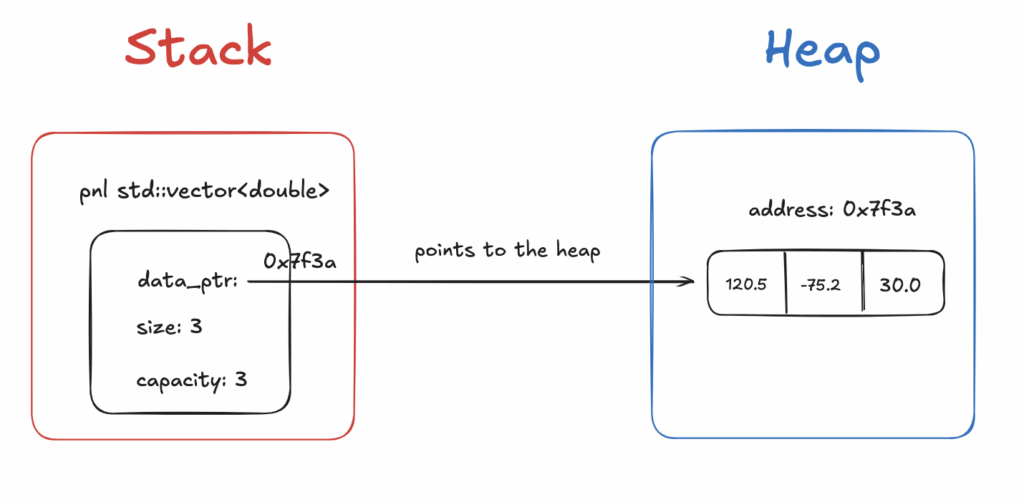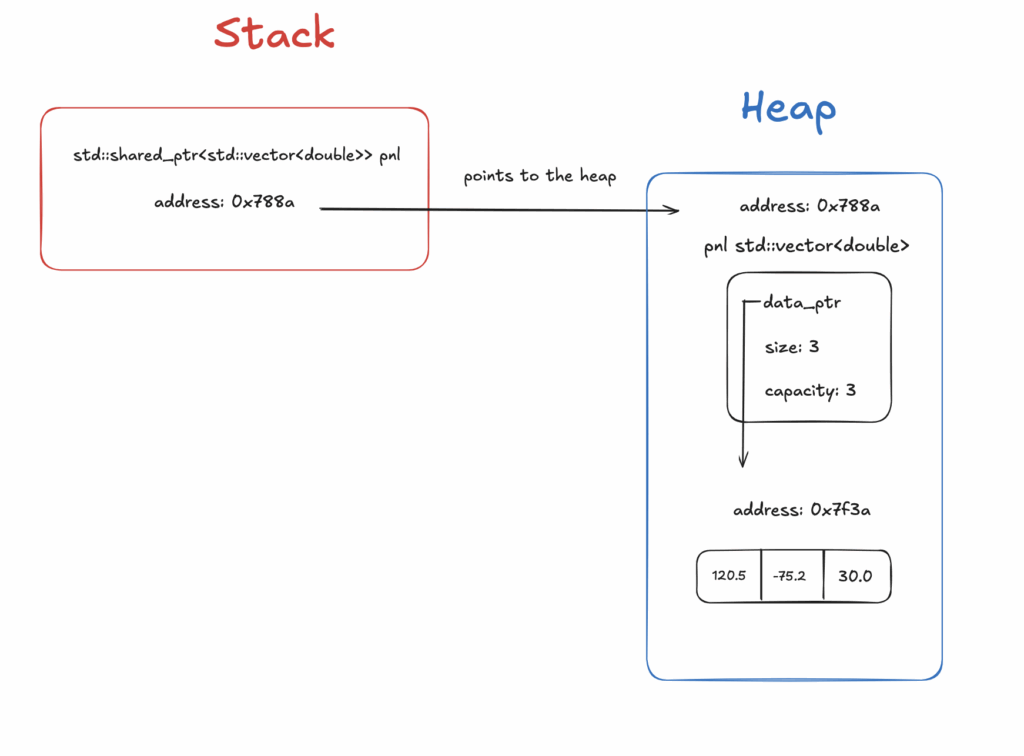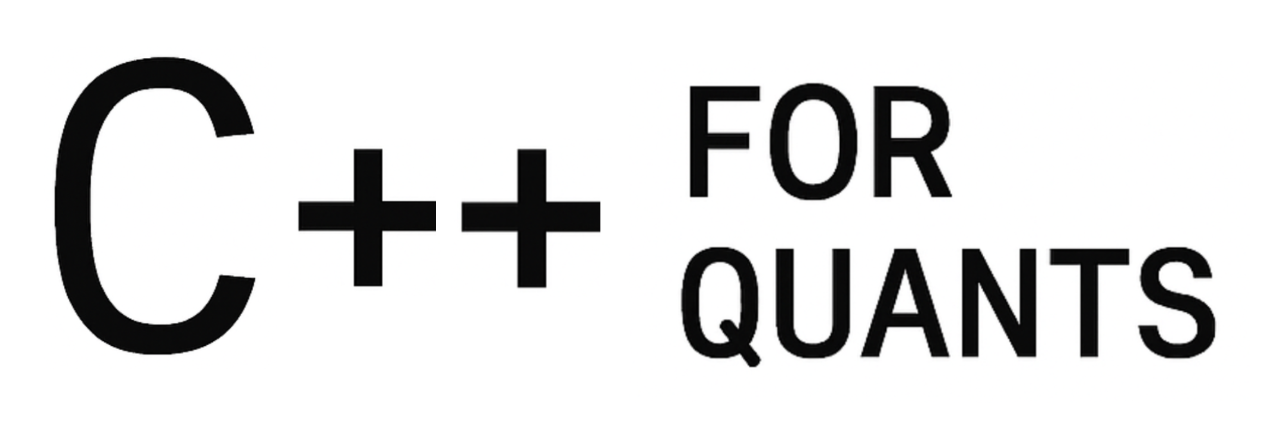Since C++11, smart pointers have become essential tools for managing memory safely and efficiently.
They eliminate the need for manual new/delete while enabling shared or exclusive ownership semantics. What are smart pointers for C++ financial data?
1. Raw Pointers vs Smart Pointers: The Evolution
C++ traditionally relied on raw pointers (T*) for dynamic memory management. While flexible, raw pointers come with risks: memory leaks, dangling references, and double deletes — especially in complex quant systems where ownership isn’t always clear.
Smart pointers, introduced in C++11, offer a safer alternative by wrapping raw pointers with automatic lifetime management.
C++11 introduced smart pointers, which wrap raw pointers with automatic memory management based on ownership models:
std::unique_ptr<T>: sole ownership, cannot be copied.std::shared_ptr<T>: shared ownership via reference counting.std::weak_ptr<T>: non-owning reference to break cycles.std::make_shared<T>()/std::make_unique<T>(): factory functions for safe allocation.
Consider this classic raw pointer pattern, here with a dummy YieldCurve object:
YieldCurve* curve = new YieldCurve(...);
// use curve
delete curve; // ❌ must remember to call this, or risk a leakWith std::shared_ptr, you simplify and secure ownership:
auto curve = std::make_shared<YieldCurve>(...); // ✅ deleted automatically when last owner goes out of scope2. Heap-Allocated Financial Structures and Smart Pointers
In financial systems, data structures like price histories, risk vectors, or trade buckets are often heap-allocated.
It’s either because of their size or because they need to be shared across multiple components or threads. Managing their lifetime correctly is crucial to avoid memory leaks or invalid access.
Let’s take a practical example of such structures: std::vector. A vector is stored on the stack, while its internal elements are managed on the heap.
void computePnL() {
std::vector<double> pnl = {120.5, -75.2, 30.0}; // stack-allocated vector
double total = 0.0;
for (double p : pnl) {
total += p;
}
std::cout << "Total PnL: " << total << std::endl;
} // ✅ `pnl` is automatically destroyed when it goes out of scopeSo a value-based vector would look like this in memory:

The stack contains basic metadata about the vector and a pointer to the heap block where the values are actually defined.
How would a vector smart shared pointer look like?
It would be a pointer defined on the stack pointing to a vector object on the heap that contains a pointer towards the actual values also on the heap. Yes, it’s a bit nested!

When the last std::shared_ptr to a heap-allocated object goes out of scope or is reset, the internal reference count drops to zero.
At that moment, unlike raw pointers, the managed object (in this case, the std::vector<double>) is automatically destroyed, and its memory is released. This ensures safe, deterministic cleanup without manual delete calls.
Let’s see with an example for shared pointers:
#include <iostream>
#include <memory>
#include <vector>
void createVector() {
auto pnl = std::make_shared<std::vector<double>>(std::initializer_list<double>{120.5, -75.2, 30.0});
std::cout << "Inside createVector(), use_count: " << pnl.use_count() << std::endl;
} // 🔥 When pnl goes out of scope, vector is destroyed (ref count drops to 0)
int main() {
createVector();
std::cout << "Back in main()" << std::endl;
}When pnl goes out of scope, vector is destroyed (ref count drops to 0) automatically.
Now, let’s talk about std::unique_ptr<T>:
While shared_ptr supports shared ownership with reference counting, unique_ptr enforces strict single ownership.
It cannot be copied, only moved making ownership transfer explicit and safe.
#include <iostream>
#include <memory>
#include <vector>
std::unique_ptr<std::vector<double>> createVector() {
auto pnl = std::make_unique<std::vector<double>>(std::initializer_list<double>{100.0, -20.0, 50.0});
std::cout << "Inside createVector(), vector size: " << pnl->size() << std::endl;
return pnl; // ownership is transferred (moved) to the caller
}
int main() {
auto vecPtr = createVector(); // vecPtr now owns the vector
std::cout << "Back in main(), first value: " << vecPtr->at(0) << std::endl;
// auto copy = vecPtr; ❌ This won't compile: unique_ptr cannot be copied
auto moved = std::move(vecPtr); // ✅ Ownership moved
if (!vecPtr)
std::cout << "vecPtr is now null after move.\n";
}
This shows how unique_ptr ensures exclusive ownership: once moved, the original pointer becomes null, and the resource is safely destroyed when the final owner goes out of scope.
Now, let’s talk about std::weak_ptr<T>:
Unlike shared_ptr, a weak_ptr does not contribute to the reference count. It’s designed for non-owning references that safely observe a shared_ptr, managed resource, especially useful to break cyclic references in shared ownership scenarios (like parent ↔ child graphs or caches).
Here’s a minimal example:
#include <iostream>
#include <memory>
#include <vector>
void observeVector() {
std::shared_ptr<std::vector<int>> data = std::make_shared<std::vector<int>>(std::initializer_list<int>{1, 2, 3});
std::weak_ptr<std::vector<int>> weakData = data; // 👀 weak observer
std::cout << "use_count: " << data.use_count() << std::endl;
if (auto locked = weakData.lock()) { // Try to temporarily access
std::cout << "Accessed value: " << locked->at(0) << std::endl;
}
data.reset(); // destroy the shared_ptr
if (auto locked = weakData.lock()) {
std::cout << "Still alive.\n";
} else {
std::cout << "Resource expired.\n";
}
}std::weak_ptr is ideal for temporary, non-owning access to a shared resource. It lets you safely check if the object is still alive without extending its lifetime: perfect for avoiding cyclic references and building efficient observers or caches.
Said differently: std::weak_ptr is a smart pointer specifically designed to observe the lifecycle of a std::shared_ptr without affecting its ownership or reference count.
3. Overhead of Using Smart Pointers in HFT
While smart pointers offer safety and convenience, they do introduce runtime overhead, especially std::shared_ptr.
🏎️ unique_ptr, by contrast, is zero-overhead in release builds — it’s just a thin RAII wrapper around a raw pointer with no reference counting.
🔁 shared_ptr maintains a reference count (typically via an internal control block). Each copy or reset updates this count atomically, which adds thread-safe synchronization costs.
🔒 weak_ptr shares this control block, adding some memory overhead, though access via .lock() is generally efficient.
In performance-critical, low-latency systems (e.g. HFT), overuse of shared_ptr can introduce cache pressure and latency spikes. It’s crucial to profile and use them only where ownership semantics justify the cost.
Each std::shared_ptr has an associated control block (on the heap) storing:
use_count(shared references)weak_count
Every copy, assignment, or destruction updates use_count atomically:
std::shared_ptr<T> a = b; // atomic incrementThese atomic ops:
- May invalidate CPU cache lines
- Cause false sharing if multiple threads access nearby memory
- Require synchronization fences, introducing latency
Each shared_ptr object requires a heap allocation for its control block. This:
- Adds malloc/free overhead
- Increases memory fragmentation
- May cause non-contiguous accesses, leading to cache misses
Also, destroying a shared_ptr with many references (e.g., in a tree or graph) may lead to:
- Long chain deletions
- Blocking deallocation spikes
- Potential STW-like moments under multi-threaded pressure
4. Summary
Here’s a clear summary table of the key points we’ve covered:
| Topic | Key Points | Notes / Code Snippet |
|---|---|---|
| Smart Pointer Types | unique_ptr, shared_ptr, weak_ptr | make_shared<T>() preferred over raw new |
unique_ptr | Single ownership, zero overhead, auto-destroy | Cannot be copied, only moved |
shared_ptr | Reference-counted ownership, auto-destroy | Copies increment ref count atomically |
weak_ptr | Non-owning observer of a shared_ptr | Use .lock() to access if still alive |
| Stack vs Heap Allocation | std::vector<T> is heap-allocated but wrapper can be stack-allocated | std::array<T, N> is truly stack-allocated |
| Why Smart Pointers? | Automate memory management, avoid leaks, support ownership semantics | Useful when passing around heap structures like vectors or trees |
| Ownership Model Example | Return shared_ptr from a function, pass to others | Reuse across functions and threads safely |
| Dangling Pointer Example | Raw pointer to stack-allocated object leads to UB | std::shared_ptr copies avoid this |
| Diagram Concepts | shared_ptr → vector → heap data | Memory is layered; ownership tracked by control block |
| Control Block (shared_ptr) | Stores ref counts, lives on heap | Introduces atomic ops and heap churn |
| Overhead Issues | Cache pressure, false sharing, heap fragmentation, latency spikes | Profiling tools: perf, Valgrind, VTune, Heaptrack |
| Monitoring Smart Pointer Usage | Atomic op count, heap allocations, cache miss rates | Avoid in tight loops or critical paths |
| Use Cases | Long-lived financial structures (e.g. Yield Curves, Risk Matrices) | Enables clean sharing, esp. across threads |
The code for the article is available here:
https://github.com/cppforquants/smartpointers/tree/main


